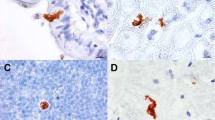Abstract
Anemia is a major clinical sign of Japanese bovine theileriosis caused byTheileria sergenti. To investigate the possible factors causing anemia in cattle, we developed a clearance test for bovine erythrocytes (Bo-RBC) in severe combined immunodeficient (SCID) mice. Clearance of Bo-RBC in the SCID mice was significantly accelerated when the mice were inoculated with a serum sample obtained from an infected calf during a highly parasitized phase but not when they were injected with a serum sample obtained during the convalescence phase. Acceleration of the clearance of Bo-RBC was also observed in mice treated with merozoite extract. Furthermore, the clearance of Bo-RBC that had been treated with merozoite extract was accelerated. A significant hemolytic activity in infected serum (highly parasitezed phase) was observed. Activities sufficient to accelerate the clearance of Bo-RBC in SCID mice and to induce in vitro hemolysis of Bo-RBC were also observed with a merozoite extract fromT. sergenti. The results suggest a possible linkage between the in vitro hemolysis of Bo-RBC and the acceleration of Bo-RBC clearance in SCID mice.
Similar content being viewed by others
References
Asaoka H, Onuma M, Kawamoto S, Takahashi K, Kawakami Y (1991) Activation of bovine peripheral blood macrophages inTheileria sergenti-infected calves. Res Vet Sci 50:23–28
Bosma GC, Custer RP, Bosma MJ (1983) A severe combined immunodeficiency mutation in the mouse. Nature 301:527–530
Burridge MJ, Kimber CD (1972) The indirect fluorescent antibody test for experimental East Coast fever (Theileria parva infection of cattle). Evaluation of a cell culture schizont antigen. Res Vet Sci 13:451–455
Catherine BB, Thierry B, Helene J, Jean CB, Thierry R, Gordon L, Luis HPS (1992)Plasmodium chabaudi p68 serine protease activity required for merozoite entry into mouse erythrocytes. Proc Natl Acad Sci USA 88:9647–9651
Chaudhuri G, Chaudhuri M, Pan A, Chang K (1989) Surface acid proteinase (gp63) ofLeishmania mexicana. J Biol Chem 264:7483–7489
Gibson U, Bosma GC, Bosma MJ (1989) Limited clonal diversity of serum immunoglobulin in leaky scid mice. Curr Top Microbiol Immunol 152:125–136
Hagiwara K, Tsuji M, Ishihara C, Tajima M, Kurosawa T, Iwai H, Takahashi K (1993a) The Bo-RBC-SCID mouse model for evaluating the efficacy of anti-theilerial drugs. Int J Parasitol 23:13–16
Hagiwara K, Tsuji M, Ishihara C, Tajima M, Kurosawa T, Iwai H, Takahashi K (1993b)Theileria sergenti infection in the Bo-RBC-SCID mouse model. Parasitol Res 79:466–470
Higuchi S, Kawamura S, Yasuda Y (1985) Scanning electron microscopy ofTheileria sergenti. Jpn J Vet Sci 47:133–137
Ishihara C, Tsuji M, Hagiwara K, Hioki K, Aikawa J, Azuma I (1994) Transfusion with xenogenic erythrocytes into SCID mice and their clearance from the circulation. J Vet Med Sci 56:1149–1154
Ishii M, Matsuda T, Takahashi K, Kawakami Y, Iwai H, Onuma M (1992) Activation of bovine peripheral blood monocyte and its suppressive effect on parasitemia inTheileria sergenti infected calves. J Vet Med Sci 54:473–477
Kawazu S, Niinuma S, Kamio T, Fujisaki K, Minami T (1991) Changes in the proportion and number of monocytes in the peripheral blood of calves infected withTheileria sergenti. J Vet Med Sci 53:341–343
McKerrow JH, Sun E, Rosenthal PJ, Bouvier J (1993) The proteases and pathogenicity of parasitic protozoa. Annu Rev Microbiol 47:821–853
Onishi T, Ueda K, Horie M, Kajikawa T, Ohishi I (1990) Serum hemolytic activity in dogs infected withBabesia gibsoni. J Parasitol 76:564–567
Robert E, Jacques B, Clement B (1986) The major surface protein ofLeishmania promastigotes in a protease. J Biol Chem 261:9098–9101
Sato M, Hirose T, Miyagami T, Sakurai H, Saito A (1986) A rise and fall of humoral antibody in calves experimentally infected withBabesia ovata orTheileria sergenti. Jpn J Vet Sci 48:599–602
Schrevel J, Deguercy A, Mayer R, Monsigny M (1990) Proteases in Malaria-infected red blood cells. Blood Cells 16:563–584
Shimizu S, Suzuki K, Nakamura K, Kadota K, Fujisaka K, Ito S, Minami T (1988) Isolation ofTheileria sergenti piroplasms from infected erythrocytes and development of an enzymelinked immunosorbent assay for serodiagnosis ofT. sergenti infections. Res Vet Sci 45:206–212
Shimizu S, Yagi Y, Nakamura Y, Shimura K, Fujisaki K, Onodera T, Minami T, Ito S (1990) Clinico-hematological observation of calves experimentally infected withTheileria sergenti. Jpn J Vet Sci 52:1337–1339
Slezak SE, Horan PK (1989) Fluorescent in vivo tracking of hematopoietic cells. I. Technical considerations. Blood 74:2172–2177
Sugimoto C, Sato M, Kawazu S, Kamio T, Fujisaki K (1991) Purification of merozoites ofTheileria sergenti from infected bovine erythrocytes. Parasitol Res 77:129–131
Sugimoto C, Onoe S, Zhuang WZ, Onuma M (1992) Detection and characterization ofTheileria sergenti proteinases. J Vet Med Sci 54:931–936
Takahashi K (1976) Studies on the infection and immunity ofTheileria sergenti. J Coll Dairying 6:179–278
Tsuji M, Hagiwara K, Takahashi K, Ishihara C, Azuma I, Siddiqui WA (1992)Theileria sergenti proliferates in SCID mice with bovine erythrocyte transfusion. J Parasitol 78:750–752
Walker WS, Singer JA, Morrison M, Jackson CW (1984) Preferential phagocytosis of in vivo aged murine red blood cells by a macrophage-like cell line. Br J Haematol 58:259–266
Yagi Y, Furuuchi S, Takahashi H, Koyoma H (1988) Abnormality of osmotic fragility and morphological disorder of bovine erythrocytes infected withTheileria sergenti. Jpn J Vet Sci 52:389–395
Yagi Y, Ito N, Kunugiyama I (1991) Decrease in erythrocyte survival inTheileria sergenti-infected calves determined by non-radioactive chromium labelling method. J Vet Med Sci 53:391–394
Author information
Authors and Affiliations
Rights and permissions
About this article
Cite this article
Hagiwara, K., Tsuji, M., Ishihara, C. et al. Serum fromTheileria sergenti-infected cattle accelerates the clearance of bovine erythrocytes in SCID mice. Parasitol Res 81, 470–474 (1995). https://doi.org/10.1007/BF00931788
Received:
Accepted:
Issue Date:
DOI: https://doi.org/10.1007/BF00931788




